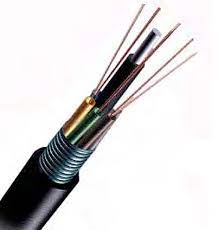Fiber optic cable is the primary and necessary medium for connecting all of the equipment in a fiber network. The most common type of fiber optic cable used in indoor applications is non-armored fiber optic cable. Armored Fiber Optic Cable is another type of fiber optic cable that is used in harsher environments and provides extra protection to the tube that houses the glass fibers. This post will explain what armored fiber optic cable is, its benefits, and the different types of armored fiber optic cable.
What exactly is Armored Fiber Optic Cable?
Armored fiber optic cable is a type of fiber optic cable with a metal or plastic armored outer jacket. The armor shields the glass fibers inside the cable from damage. It is appropriate for harsher environments, such as outside or high-traffic areas. The armor also protects the cable from damage caused by rodents, construction, or unintentional knocks and cuts.
The armored fiber optic cable, as opposed to the common unarmored fiber optic cable, has an additional outer protective layer. Metal braid, fiber yarn, glass yarn, or polyethylene can all be used as armoring materials. A dielectric core, Kevlar strength members, aluminum Mylar tape, a stainless-steel braid or corrugated aluminum sheath, and a polyethylene jacket are typical components of an armored fiber optic cable. The diagram below depicts the construction of a typical armored fiber optic cable.
Types of Armored Fiber Optic Cable
Classification Based on Metal Tube
We can categorize interlock armored fiber optic cable and corrugated armored optic cable based on the metal tube. Interlocking armour is a type of aluminium armour that is helically wrapped around a cable and is commonly found in indoor and indoor/outdoor cables. Corrugated armor is a coated steel tape that is wrapped longitudinally around the cable and is commonly used in direct burial cables. Both armored fiber cables and bare fiber cables can be installed in hazardous environments such as those with high levels of dust, oil, gas, moisture, or even damage-causing rats.
Classification According to the application environment
We can categorize it as outdoor Armored Fiber Optic Cable or indoor Armored Fiber Optic Cable based on the application environment.
Indoor Armored Fiber Optic Cable safeguards fiber in applications prone to rodents or physical damage. Crush resistance is provided by the aramid yarns while cutting and abrasion resistance is provided by the steel tube. Indoor Armored Fiber Optic Cable is ideal for high-density cabling environments such as data centers.
Outdoor Armored Fiber Optic Cable is used in aerial or direct burial applications. The corrugated steel tube resists crush, while the aluminum interlocking armor resists rodents and abrasion. Outdoor Armored Fiber Optic Cable is used for long-distance connectivity, such as campus backbones and building-to-building connectivity.
Advantages of Armored Fiber Optic Cable
There are numerous advantages to using armored fiber optic cable.
- Keep the fiber cable safe from physical harm.
The first advantage is that the armor shields the fiber optic strands from physical damage. It may be significant in high-activity areas, such as construction or industrial zones. The armored fiber cable can also protect it from being slashed or punctured by sharp objects.
- Resistance to temperature and mechanical stress
Armored fiber optic cables are also more resistant to heat than standard fiber optic cables. This is due to the armor’s ability to protect the glass from heat damage. Armored fiber optic cables are also resistant to temperature changes, which can damage regular fiber optic cables.
Furthermore, armored fiber optic cables are less susceptible to mechanical stress. This is due to the armor protecting the glass from damage caused by changes in pressure or tension.
- Improved toughness in harsh environments
In general, armored fiber optic cables are more durable. This is due to the armor’s ability to protect the glass from damage caused by water, sunlight, or other environmental factors. Fiber optic cables that have been armored can also be buried underground without being damaged.
- Lower your maintenance costs.
One of the most significant advantages of armored fiber optic cable is that it can help you save money on maintenance. This is because armored fiber optic cable is far more durable and resistant to damage than standard fiber optic cable.
- Longer lifespan
Armored fiber optic cable is designed to last longer than unarmored fiber optic cable. The armored casing protects the fiber from damage, extending the life of the cable. Furthermore, armored optical fibers are less susceptible to environmental factors like humidity and dust, which shortens their lifespan. Regular fiber optic cables have a lifespan of 10-15 years, whereas armored fiber optic cables have a lifespan of up to 230 years.
Conclusion
Armored fiber optic cable is used in a variety of applications for a variety of purposes. Armored fiber optic cable offers numerous advantages, including increased durability, resistance to environmental factors, and a longer lifespan. You can make the best decision for your application by understanding the various armored fiber optic cable types.
Contact Linden Photonics to get a quote or Call Us at (978) 392-7985


One comment
Jordan
05/21/2023 at 9:26 pm
You should take part in a contest for one of the highest quality sites on the web. I most certainly will recommend this web site!